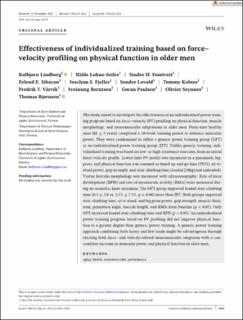| dc.contributor.author | Lindberg, Kolbjørn Andreas | |
| dc.contributor.author | Lohne-Seiler, Hilde | |
| dc.contributor.author | Fosstveit, Sindre Herskedal | |
| dc.contributor.author | Sibayan, Erlend E. | |
| dc.contributor.author | Fjeller, Joachim S. | |
| dc.contributor.author | Løvold, Sondre | |
| dc.contributor.author | Kolnes, Tommy M. | |
| dc.contributor.author | Vårvik, Fredrik Tonstad | |
| dc.contributor.author | Berntsen, Sveinung | |
| dc.contributor.author | Paulsen, Gøran | |
| dc.contributor.author | Seynnes, Olivier R. | |
| dc.contributor.author | Bjørnsen, Thomas | |
| dc.date.accessioned | 2022-12-01T09:25:09Z | |
| dc.date.available | 2022-12-01T09:25:09Z | |
| dc.date.created | 2022-04-10T15:13:17Z | |
| dc.date.issued | 2022 | |
| dc.identifier.citation | Scandinavian Journal of Medicine & Science in Sports. 2022, 32(6), Side 1013-1025. | en_US |
| dc.identifier.issn | 0905-7188 | |
| dc.identifier.uri | https://hdl.handle.net/11250/3035228 | |
| dc.description | This is an open access article under the terms of the Creative Commons Attribution License, which permits use, distribution and reproduction in any medium, provided the original work is properly cited. | en_US |
| dc.description.abstract | The study aimed to investigate the effectiveness of an individualized power training program based on force–velocity (FV) profiling on physical function, muscle morphology, and neuromuscular adaptations in older men. Forty-nine healthy men (68 ± 5 years) completed a 10-week training period to enhance muscular power. They were randomized to either a generic power training group (GPT) or an individualized power training group (IPT). Unlike generic training, individualized training was based on low- or high-resistance exercises, from an initial force–velocity profile. Lower-limb FV profile was measured in a pneumatic leg-press, and physical function was assessed as timed up-and-go time (TUG), sit-to-stand power, grip strength, and stair-climbing time (loaded [20kg] and unloaded). Vastus lateralis morphology was measured with ultrasonography. Rate of force development (RFD) and rate of myoelectric activity (RMA) were measured during an isometric knee extension. The GPT group improved loaded stair-climbing time (6.3 ± 3.8 vs. 2.3% ± 7.3%, p = 0.04) more than IPT. Both groups improved stair-climbing time, sit to stand, and leg press power, grip strength, muscle thickness, pennation angle, fascicle length, and RMA from baseline (p < 0.05). Only GPT increased loaded stair-climbing time and RFD (p < 0.05). An individualized power training program based on FV profiling did not improve physical function to a greater degree than generic power training. A generic power training approach combining both heavy and low loads might be advantageous through eliciting both force- and velocity-related neuromuscular adaptions with a concomitant increase in muscular power and physical function in older men. | en_US |
| dc.language.iso | eng | en_US |
| dc.subject | aging | en_US |
| dc.subject | health | en_US |
| dc.subject | neuromuscular | en_US |
| dc.subject | performance | en_US |
| dc.title | Effectiveness of individualized training based on force: Velocity profiling on physical function in older men | en_US |
| dc.type | Peer reviewed | en_US |
| dc.type | Journal article | en_US |
| dc.description.version | publishedVersion | en_US |
| dc.rights.holder | © 2022 The Authors | en_US |
| dc.source.pagenumber | 1013-1025 | en_US |
| dc.source.volume | 32 | en_US |
| dc.source.journal | Scandinavian Journal of Medicine & Science in Sports | en_US |
| dc.source.issue | 6 | en_US |
| dc.identifier.doi | 10.1111/sms.14157 | |
| dc.identifier.cristin | 2016501 | |
| dc.description.localcode | Institutt for fysisk prestasjonsevne / Department of Physical Performance | en_US |
| cristin.ispublished | true | |
| cristin.fulltext | original | |
| cristin.qualitycode | 2 | |
